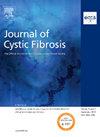重新利用 DNase I 和藻酸盐裂解酶降解人工痰培养基中生长的金黄色葡萄球菌和铜绿假单胞菌双菌种生物膜基质:与广谱抗生素联合使用的体外活性评估。
IF 5.4
2区 医学
Q1 RESPIRATORY SYSTEM
引用次数: 0
摘要
背景:与生物膜相关的肺部感染给囊性纤维化患者的治疗带来了挑战,尤其是涉及多种细菌种类时。酶降解生物膜基质可能是提高抗生素疗效的潜在解决方案。本研究调查了 DNase I(常用于囊性纤维化的粘液溶解活性)在铜绿假单胞菌和金黄色葡萄球菌双菌种生物膜中针对细胞外 DNA 的再利用,以及与藻酸盐裂解酶和广谱抗生素的潜在协同作用:在人工痰培养基中培养金黄色葡萄球菌和铜绿假单胞菌的双种生物膜。通过测量生物膜生物量和存活计数来评估其活性。使用共聚焦显微镜观察基质降解和细菌量减少的情况。生物膜的粘弹性通过流变学进行估算:结果:只有将酶鸡尾酒与两种抗生素结合使用,以及使用超治疗水平的 DNase I 和高浓度的藻酸盐裂解酶,才能几乎完全破坏生物膜。含有非色素粘液铜绿假单胞菌的生物膜尽管粘弹性较低,但需要更高浓度的抗生素。与此相反,对于含有色素粘液铜绿假单胞菌的生物膜,不同处理方法的疗效与其导致的生物膜弹性和粘度降低之间存在相关性:在这种复杂的高耐药性生物膜模型中,酶被证明是增强抗生素活性的有用佐剂。然而,高浓度酶的必要性强调了在考虑临床应用之前进行彻底的浓度-反应评估和安全评估的必要性。本文章由计算机程序翻译,如有差异,请以英文原文为准。
Repurposing DNase I and alginate lyase to degrade the biofilm matrix of dual-species biofilms of Staphylococcus aureus and Pseudomonas aeruginosa grown in artificial sputum medium: In-vitro assessment of their activity in combination with broad-spectrum antibiotics
Background
Biofilm-associated pulmonary infections pose therapeutic challenges in cystic fibrosis patients, especially when involving multiple bacterial species. Enzymatic degradation of the biofilm matrix may offer a potential solution to enhance antibiotic efficacy. This study investigated the repurposing of DNase I, commonly used for its mucolytic activity in cystic fibrosis, to target extracellular DNA within biofilms, as well as potential synergies with alginate lyase and broad-spectrum antibiotics in dual-species biofilms of Pseudomonas aeruginosa and Staphylococcus aureus.
Methods
Dual-species biofilms were grown in artificial sputum medium using S. aureus and P. aeruginosa isolated by pairs from the same patients and exposed to various combinations of enzymes, meropenem, or tobramycin. Activity was assessed by measuring biofilm biomass and viable counts. Matrix degradation and decrease in bacterial load were visualized using confocal microscopy. Biofilm viscoelasticity was estimated by rheology.
Results
Nearly complete destruction of the biofilms was achieved only if combining the enzymatic cocktail with the two antibiotics, and if using supratherapeutic levels of DNase I and high concentrations of alginate lyase. Biofilms containing non-pigmented mucoid P. aeruginosa required higher antibiotic concentrations, despite low viscoelasticity. In contrast, for biofilms with pigmented mucoid P. aeruginosa, a correlation was observed between the efficacy of different treatments and the reduction they caused in elasticity and viscosity of the biofilm.
Conclusions
In this complex, highly drug-tolerant biofilm model, enzymes prove useful adjuvants to enhance antibiotic activity. However, the necessity for high enzyme concentrations emphasizes the need for thorough concentration-response evaluations and safety assessments before considering clinical applications.
求助全文
通过发布文献求助,成功后即可免费获取论文全文。
去求助
来源期刊

Journal of Cystic Fibrosis
医学-呼吸系统
CiteScore
10.10
自引率
13.50%
发文量
1361
审稿时长
50 days
期刊介绍:
The Journal of Cystic Fibrosis is the official journal of the European Cystic Fibrosis Society. The journal is devoted to promoting the research and treatment of cystic fibrosis. To this end the journal publishes original scientific articles, editorials, case reports, short communications and other information relevant to cystic fibrosis. The journal also publishes news and articles concerning the activities and policies of the ECFS as well as those of other societies related the ECFS.
 求助内容:
求助内容: 应助结果提醒方式:
应助结果提醒方式:


